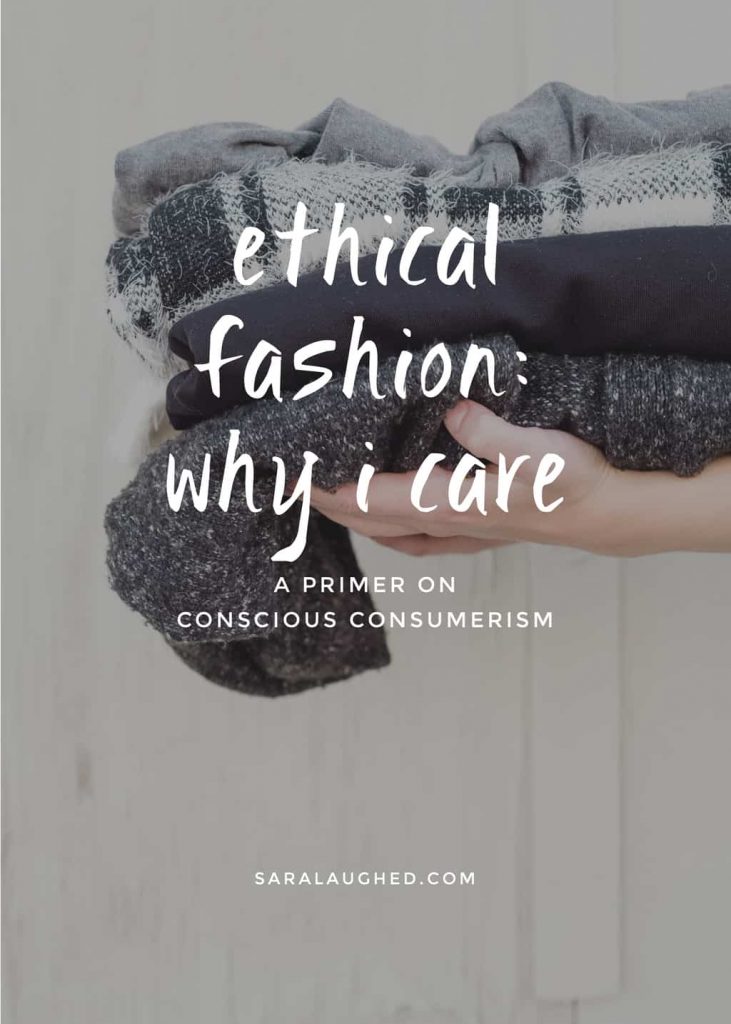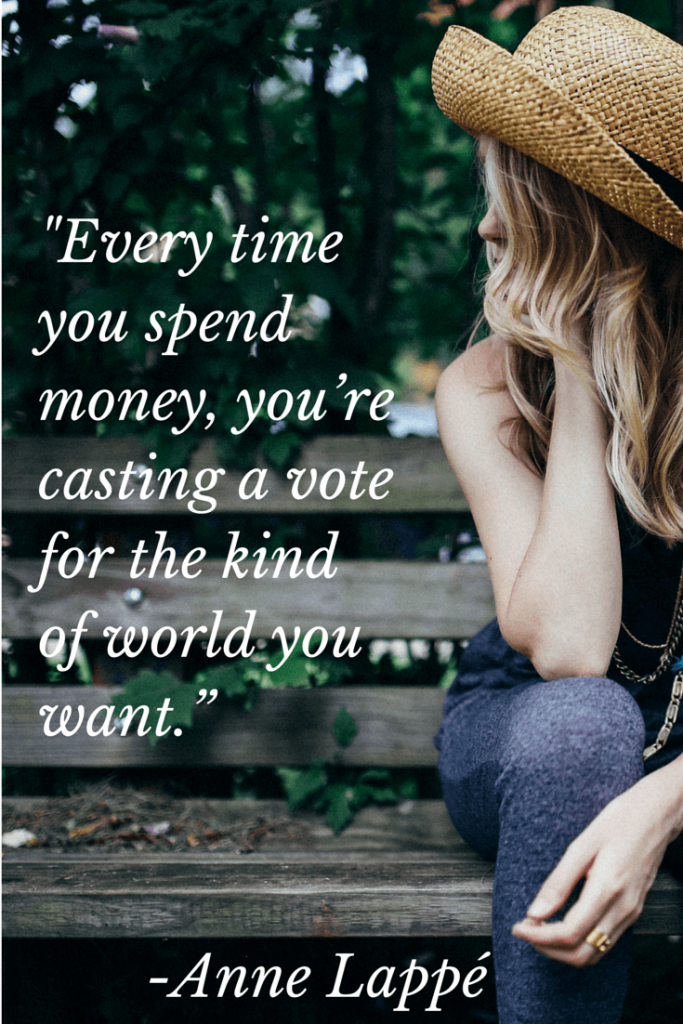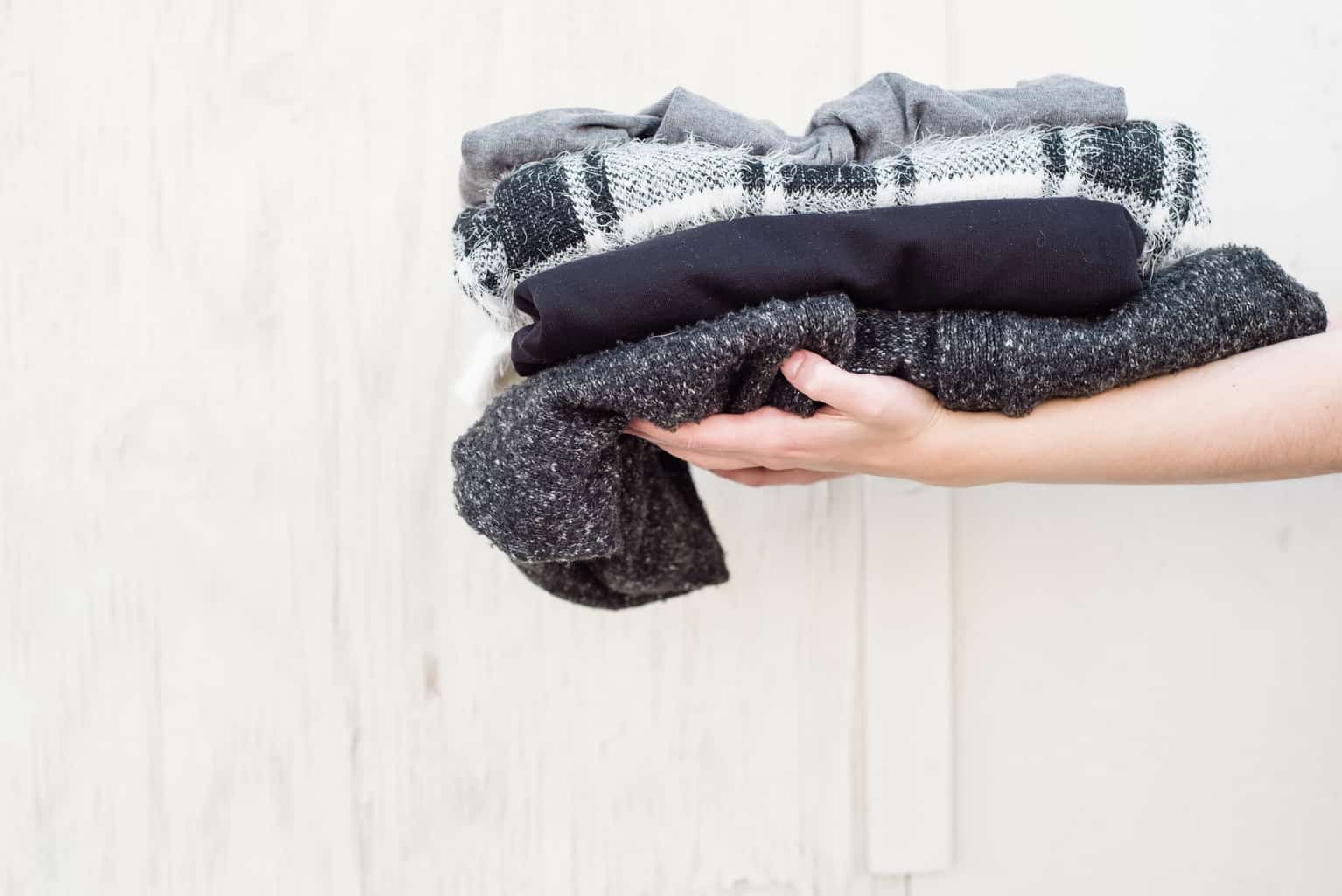When I was ten, I wanted to be a fashion designer. I was constantly sketching dresses, devouring fashion books, and cutting up magazines. I had passion. But the fashion world was not made for hearts (or bodies) like mine, so after several years, that dream faded away to be replaced by newer, bigger dreams. Now I dress about as well as the average college student – which is to say, not so well. I generally wear jeans, dresses, and cardigans (sometimes all at once – ouch), and for a long time, clothing didn’t take up a lot of my thought.

But a few years ago, I began to take an interest in ethical fashion. I had always been vaguely aware of the systems and processes that allowed me to wear the clothes I did, but it was more comfortable not to think about them. It was easy not to think about the underpaid hands that sewed my $12 shirt, or the pollutant dyes that went into my jeans.
But not thinking about them didn’t make those problems go away. It perpetuated them.
I had this uncomfortable realization when I was about sixteen. Being sixteen, I allowed it to settle for a little while before I did anything. I didn’t have a ton of clothes, after all. I was conscious about where I bought some of my clothing. And when I didn’t want something anymore, it wasn’t like I just threw it out – I donated it to a charity shop or homeless shelter. That wasn’t so bad, right? So I said to myself.
And then, a while later, I heard this quote:
 “Every time you spend money, you’re casting a vote for the kind of world you want.”
“Every time you spend money, you’re casting a vote for the kind of world you want.”
I realized that my behavior – buying cheap clothing, only wearing some of it, and then either donating it or throwing out the rest – was not in line with the ways I liked to think I lived. It was not helping the world, and was actually, actively making it worse.
Please know that I am not saying this to shame or guilt-trip you – not even a little bit. I am saying this because, for the longest time, I didn’t know. I didn’t realize where my money was going, and what sort of system it was supporting. And I didn’t realize that I had the opportunity to help make it any better.
But I did, and so do you.
The first step is knowing and understanding why this is a problem. Now, take a deep breath, because things are about to get really bad before they get better. But they will get better, I promise.
We have a clothing problem
The American clothing market is a $225 billion dollar industry. Americans purchase nearly 20 billion clothing items per year, while British citizens have an estimated total of 46.7 billion dollars’ worth of unworn clothing in their closets. The clothing company Zara alone processes 1 million pieces of clothing a day.
Why is this a problem?
First of all, it matters on an environmental scale. The Chinese textile industry puts out about 3 billion tons of soot per year. The Environmental Protection Agency reports that the average American throws away 10 pounds of clothes annually, only 15% of which is recycled later. Of the many clothes that Americans so kindly donate to various organizations, only some of it is given on to others; because of its sheer volume, much of it is resold, or deemed unsellable and dumped in a landfill.
Our clothing problem makes an economic difference as well. Only 2% of American-owned clothes are now made in the United States, down from 95% in 1960. As you can imagine, this has led to a decrease in American jobs, with over 750,000 jobs in the textile industry lost between 1990 and 2011 alone – 80% of the apparel manufacturing jobs in the US.
What matters most to me, however, is the working and living conditions of the people who manufacture the clothing I wear. Many factories have low pay and poor working conditions for their laborers, and if I don’t know how and where my clothing is manufactured, I can’t ensure that I am not supporting that system of oppression. You can learn more about the conditions of some of the people who make clothing here.
Ethical Fashion: What You Can Do
This is a huge global and societal problem, and for a long time it felt totally insurmountable to me. But luckily, there are many companies who strive to make clothing that is ethical in a variety of ways: environmentally, in terms of manufacturing, and in terms of societal impact. There are companies like Tentree, who plant ten trees for every clothing item sold. There are brands like Synergy, who make all their clothing our of Certified Organic Cotton, use low-impact dyes in their clothes, and are currently employing 150 Nepali women with a living wage and safe working standards. By supporting companies who value ethical production, we can vote with our money and support the causes we care about.
My Ethical Fashion Goals
I am certainly far from perfect in this regard. Many of my clothes are not ethically sourced, or are from chain stores whose policies I haven’t fully examined. Unfortunately, often the companies we would like to support are expensive, because paying their employees a living wage and using environmentally-friendly materials is more costly than the alternative. However, I’ve realized over time that I need far fewer clothing items than I used to believe. As such, the money that would go to more clothes can now go to better clothes.
I would love it if, eventually, all my clothing were ethically-sourced and made. However, getting rid of my “fast fashion” clothes and replacing my entire wardrobe is neither conscious nor financially realistic, so until then, my goals are:
- To try to maintain a wardrobe of 30 items or less.
- To only purchase new items to replace items that are torn, broken, or no longer fit.
- That any new items I purchase should be thoroughly researched and ethically made.
Ethical Fashion Resources
We are lucky to live in an age where we have access to the Internet, which can be a great resource for educating ourselves. There are many websites online that are dedicated to helping you make ethical consumer choices. Here are a few of my favorites.
- Eco Fashion World’s Eco Fashion Guide has lists of ethical companies in many different areas of shopping.
- Know the Chain, a website which I found through Oh Simple Thoughts’ wonderful post on ethical fashion. They work to compile a directory of different companies’ responses to the California Transparency in Supply Chains Act, which obliges large companies to disclose the degree to which they maintain standards preventing trafficking, slavery, and child labor in their supply chains.
- Free2Work, also found via OST, which scores different companies on their transparency and ethical policies.
- The documentary The True Cost, available on Netflix, explores the problems of fast fashion, and brands that are breaking the mold.
Those are my thoughts on ethical fashion and why it’s important to me. I’m planning to make this a series in which I feature some of my favorite companies in different areas – plus sized ethical fashion, budget ethical fashion, active ethical fashion, etc. In the meantime, I hope you’ll take a look at the resources above and let me know what you think of this series in the comments!






Woah those numbers are tough to look at :/ especially the part about only 2% of our clothes being made in the US. This definitely makes me think about my next clothing purchases.
I’m stopping by from the peonies 🙂
Anna | sheisjoyful.com
Thanks for commenting, Anna! I know it’s hard to look at, but luckily we can make a difference. (:
This is an area that I’ve wanted to become more educated on. Have you heard of Krochet Kids? They partner with women in different parts of the country and help educate and provide jobs. My husband got me a sweater for Christmas and I love it!
I hadn’t heard of Krochet Kids, but I looked them up and they look great! Thanks for bringing them to my attention!
Have you read “Where am I wearing?” It’s a fascinating book about a guy who chose a few items from his wardrobe and managed to track down the textile factories where those items were made. It’s very eye-opening, that’s for sure. It’s worth it to be aware of where our clothing comes from.
This sounds so interesting! Thanks for the recommendation, Rachel!
I agree wholeheartedly with you, this is something that i’ve been aware of but never really thought to do anything about. And as i’ve gotten older, i’ve gotten more okay with spending more $$ on clothing, so it’ll last longer than 6 months. but to know that those who made the item is being properly treated? priceless. thanks for the links and i look forward to more of this series
Thank you so much, Laura! I definitely thought about it for a long time before I started to change my behavior, and I know that that feeling is priceless to me, too. I’m excited to share more of the series with you! (:
Hats off to you Sara.
Great post and well researched! I sometimes have trouble writing about this topic in a way that doesn’t end up guilt tripping people, so I’m thankful for your voice in the conversation.
Signed, a fellow ethical clothing purchaser and blogger, Leah
http://stylewiseblog.blogspot.com
I am sooooo thankful that I found these posts!!! THANK YOU! I feel incredibly overwhelmed with the harm I have been causing to other people by shopping cheaply. I want to do more and I didn’t know how, but now I do, and I’m excited!!!!
It can be done! There are so many resources available. Good luck in your journey and congratulations to you for doing this!
Sara, Thanks for being so transparent and for helping others think about what they buy. I recently published a website, http://www.changetheworldbyhowyoushop.com which is an Ethical Shopping Guide for the U.S. for all kinds of products, including clothing. Hopefully this will help give you and others some more ideas and make ethical shopping easier as it has for me!